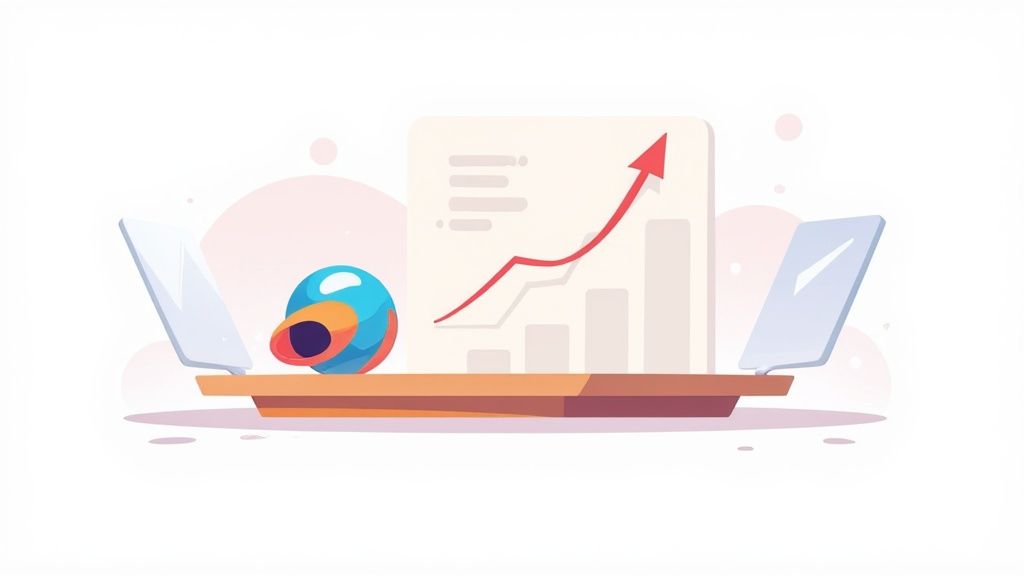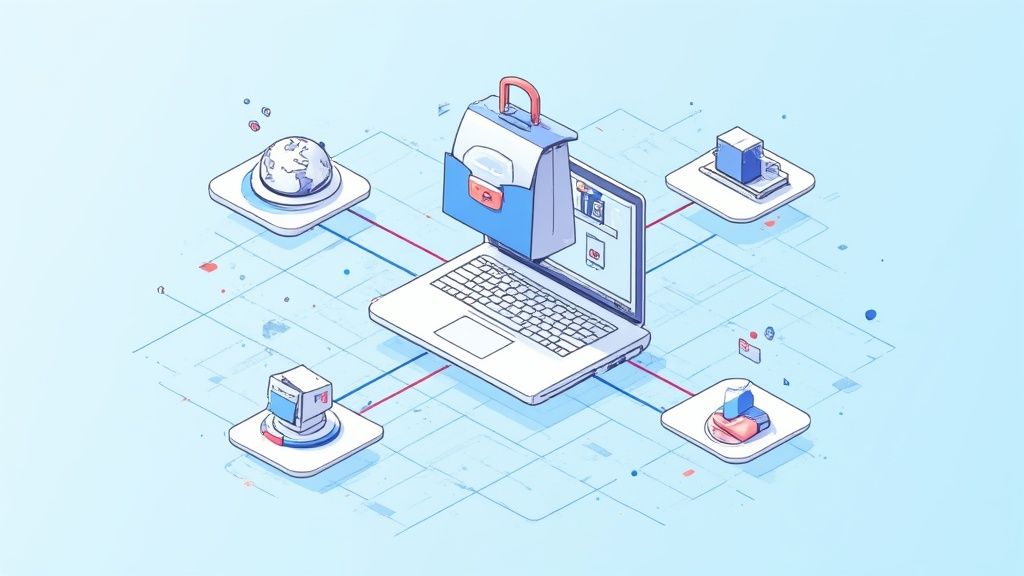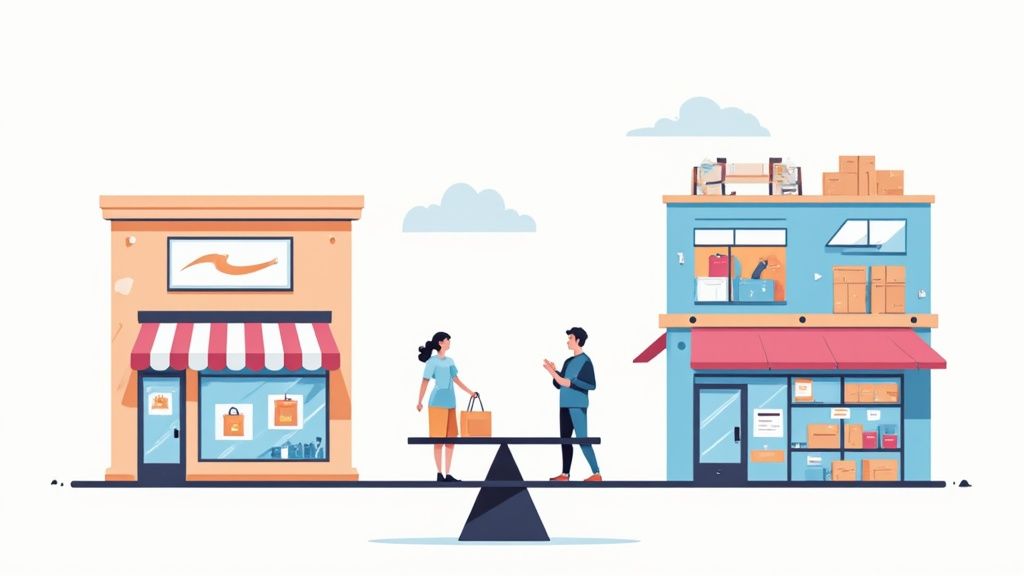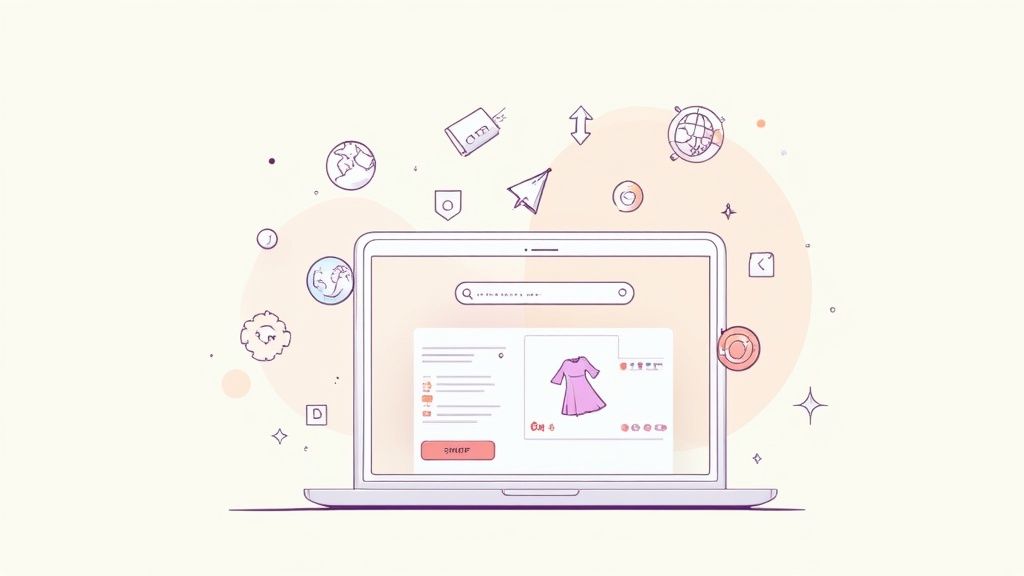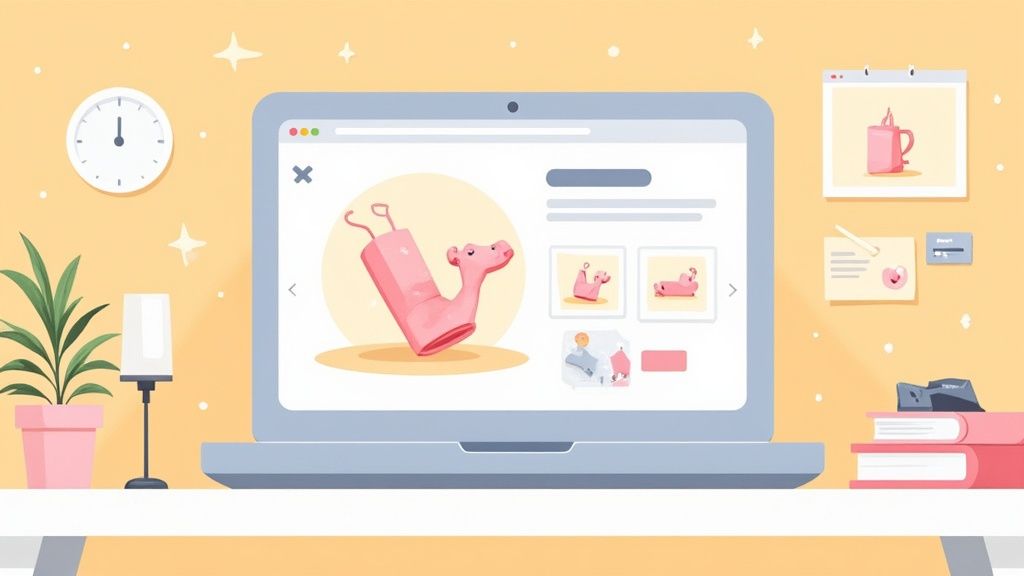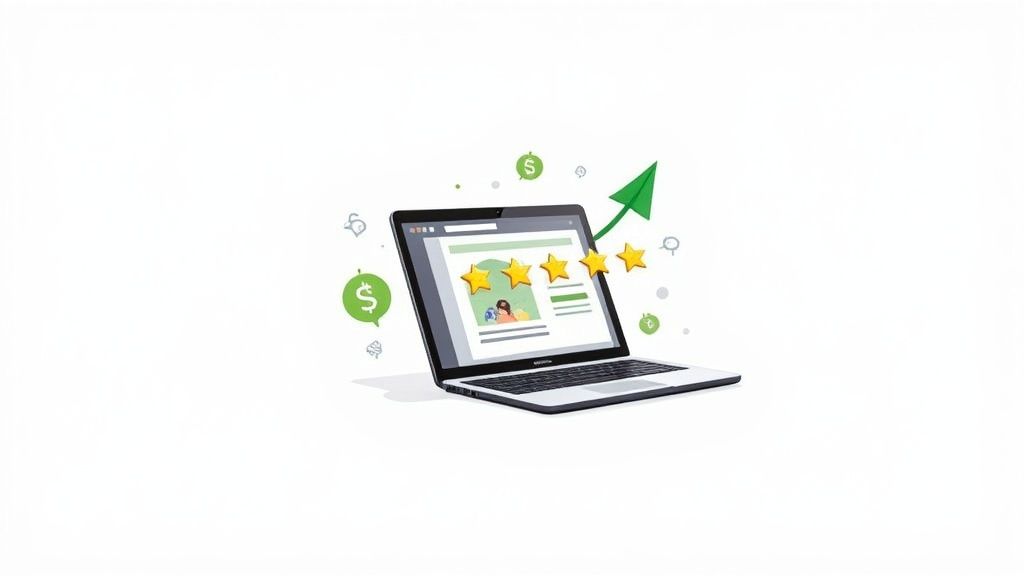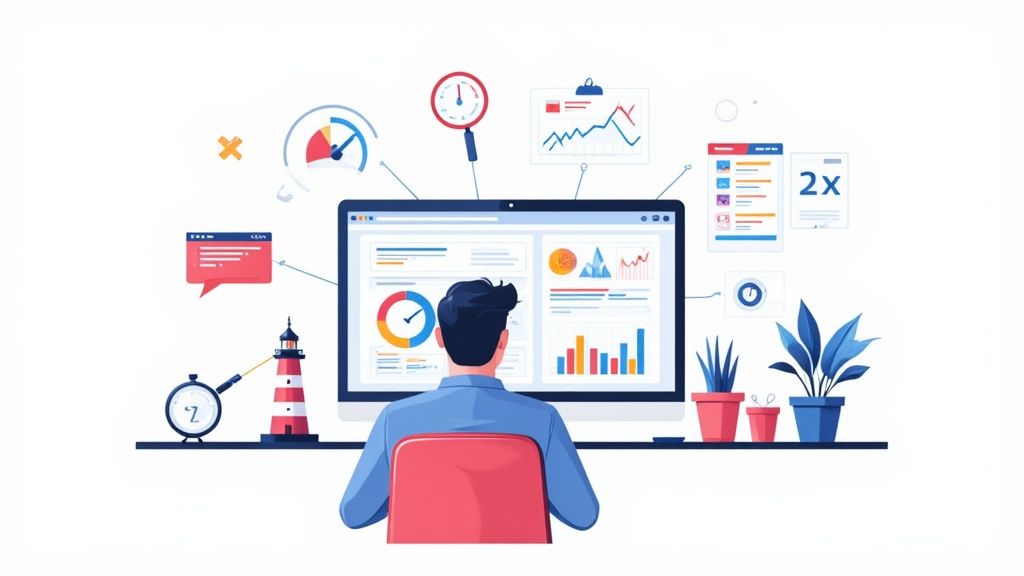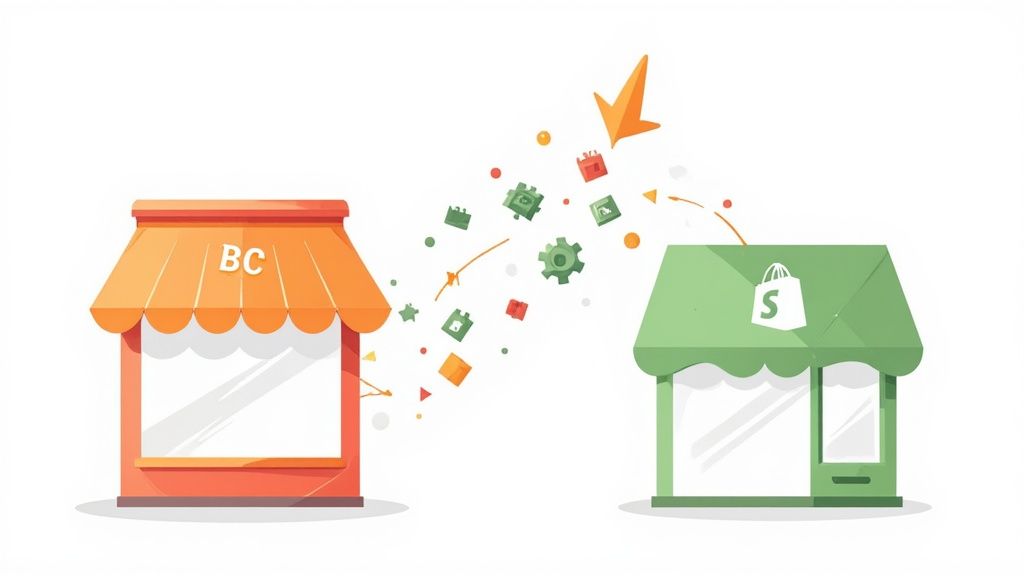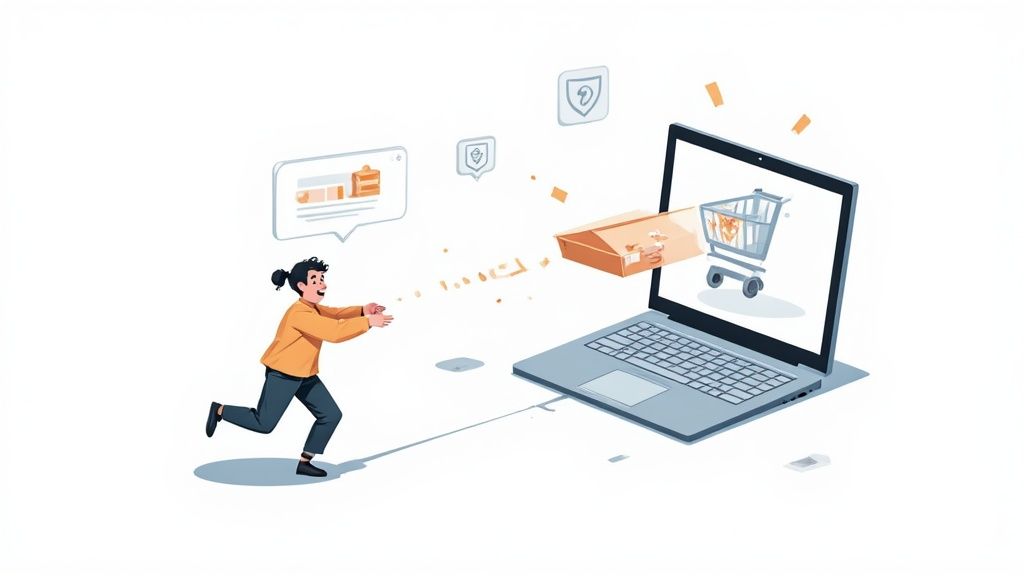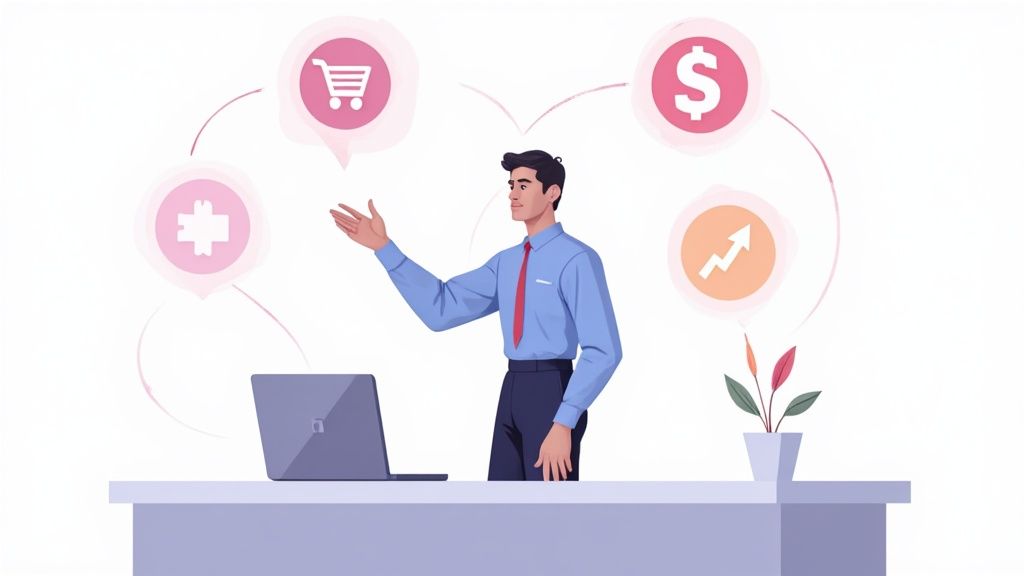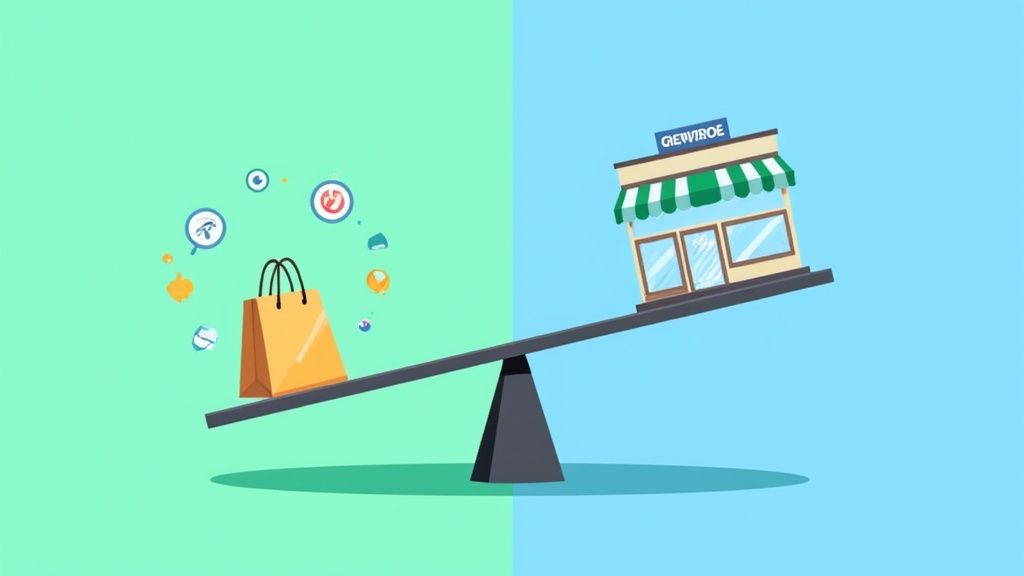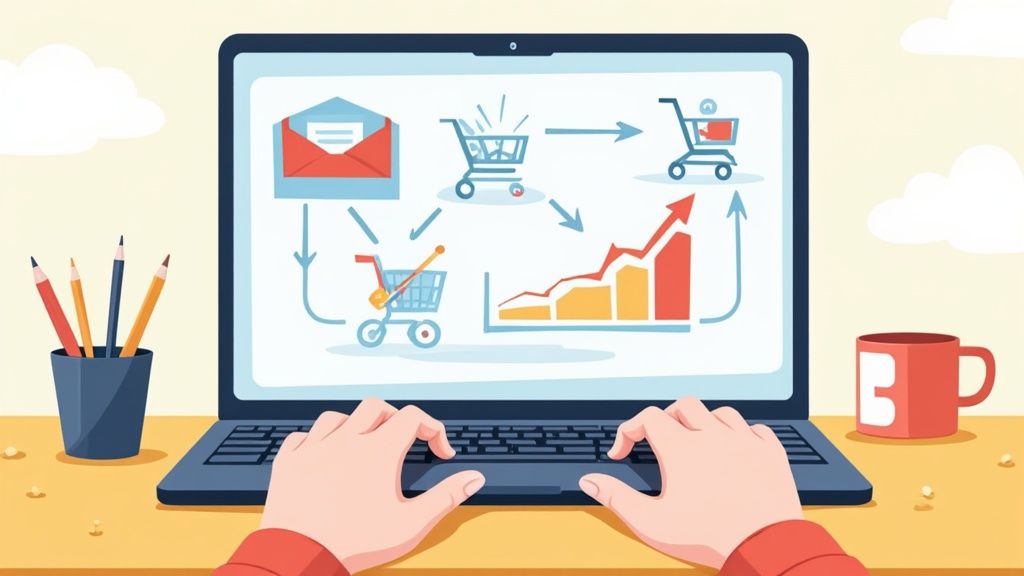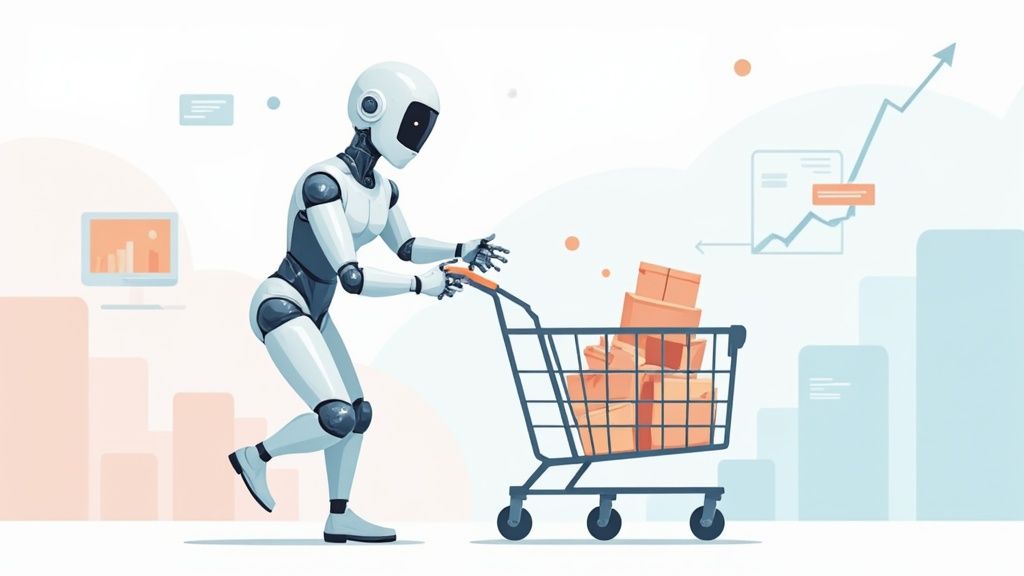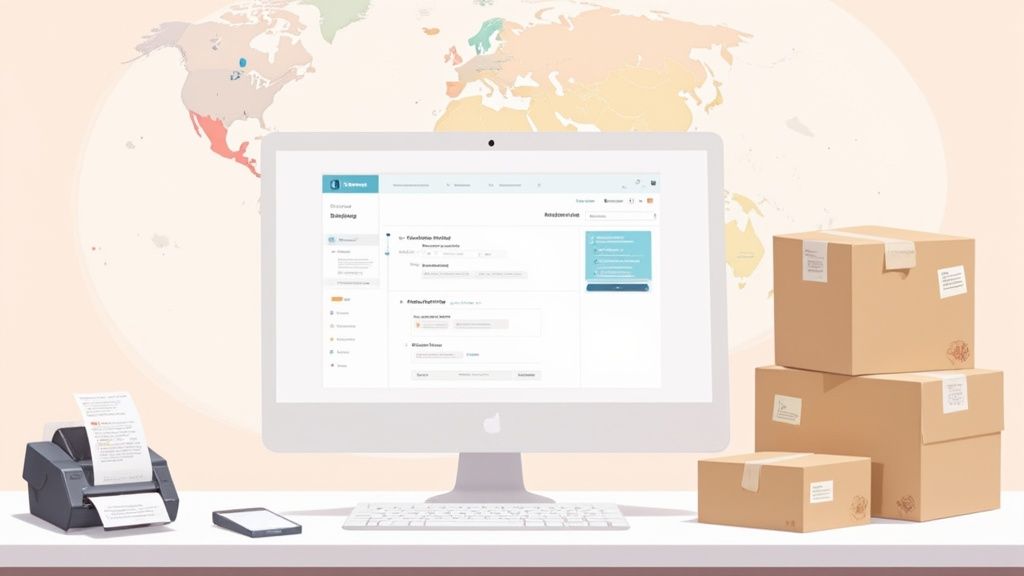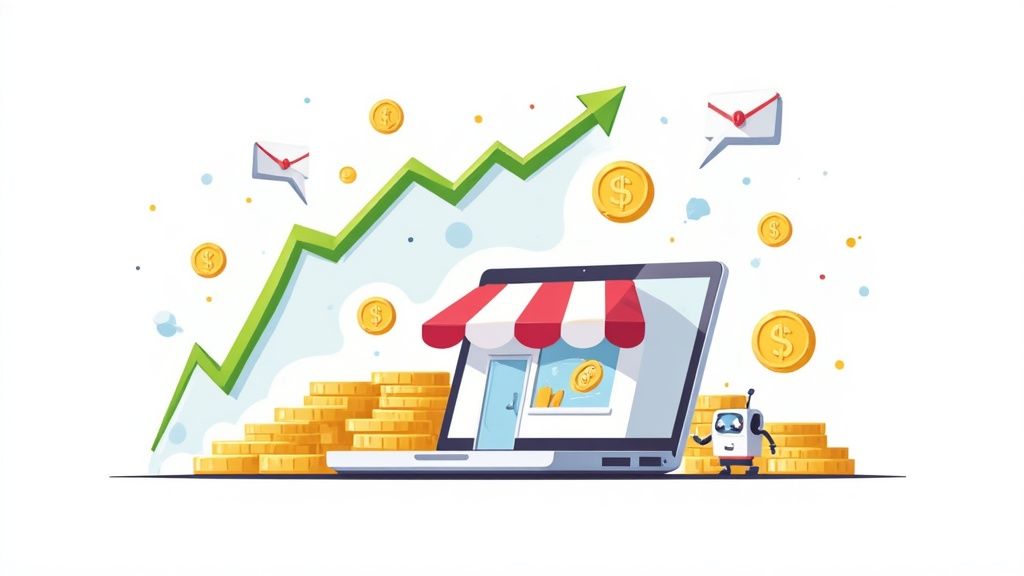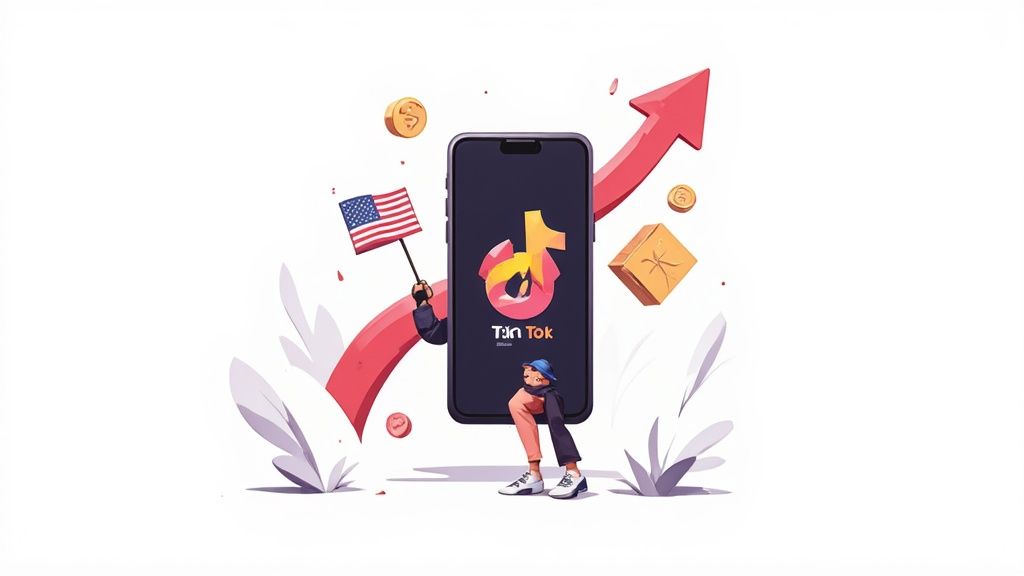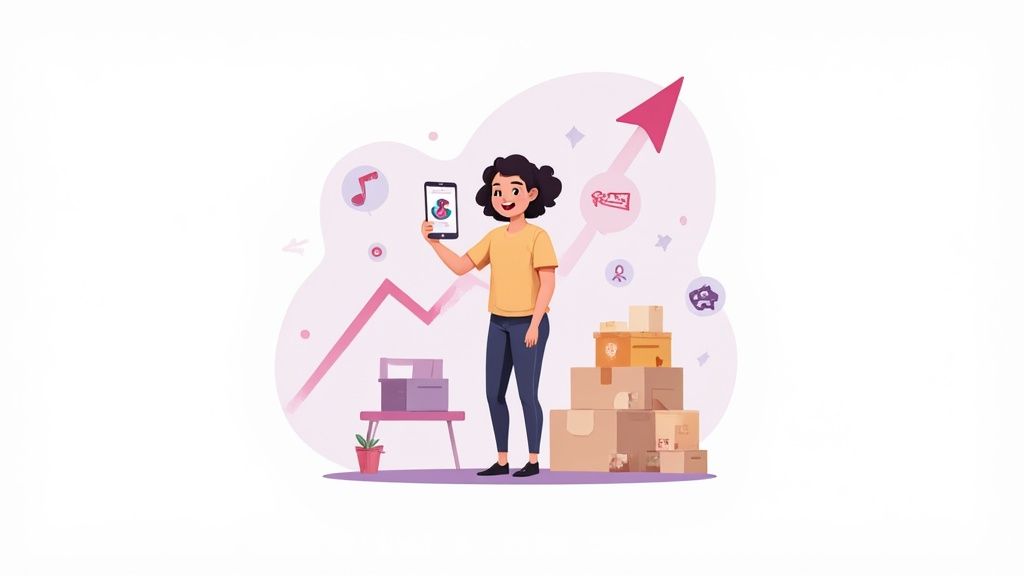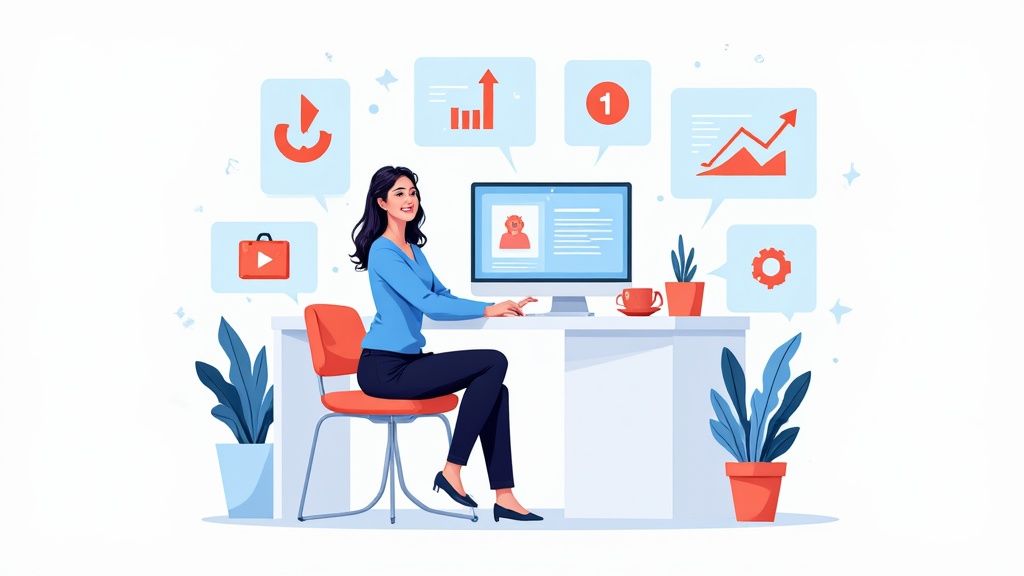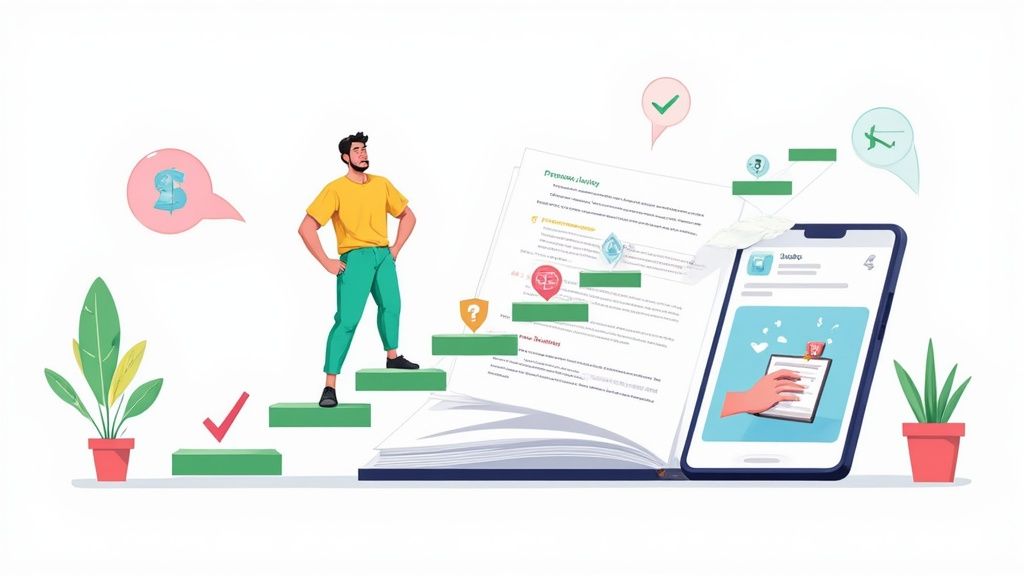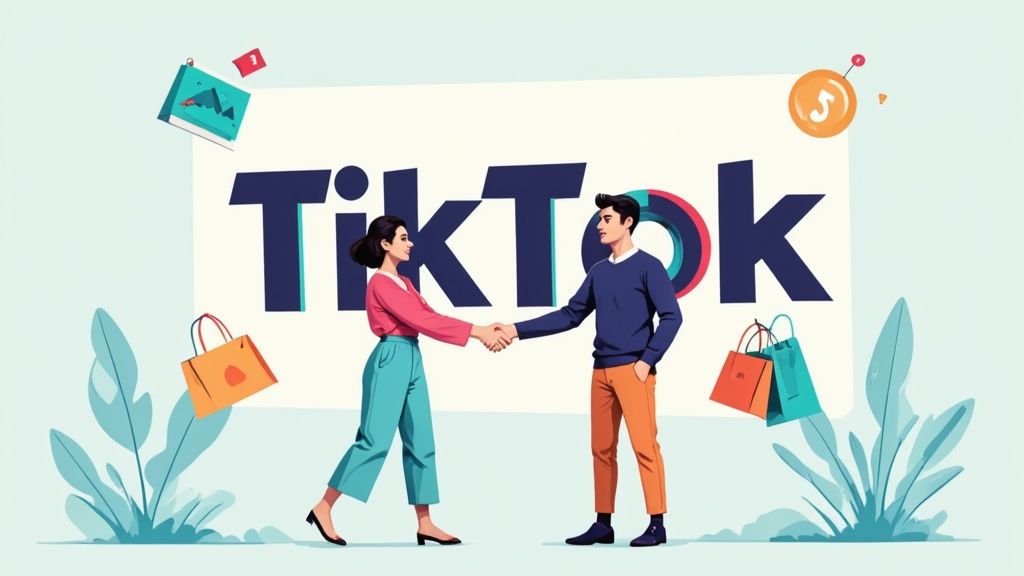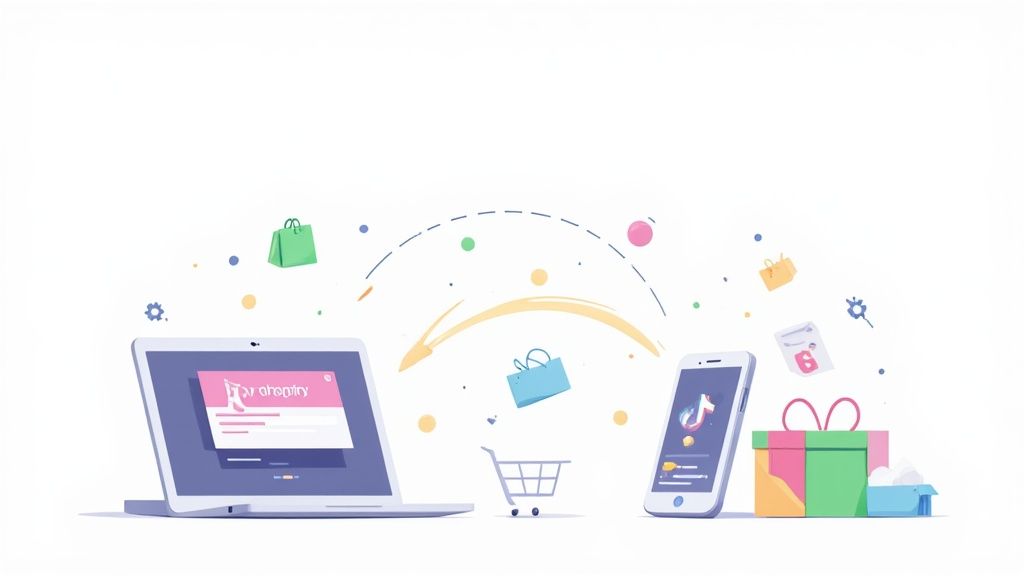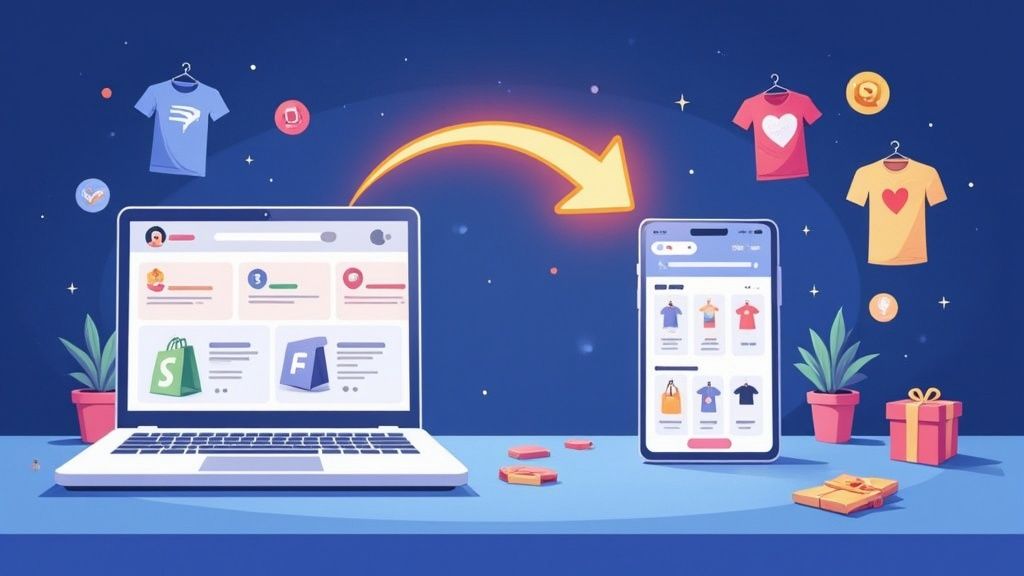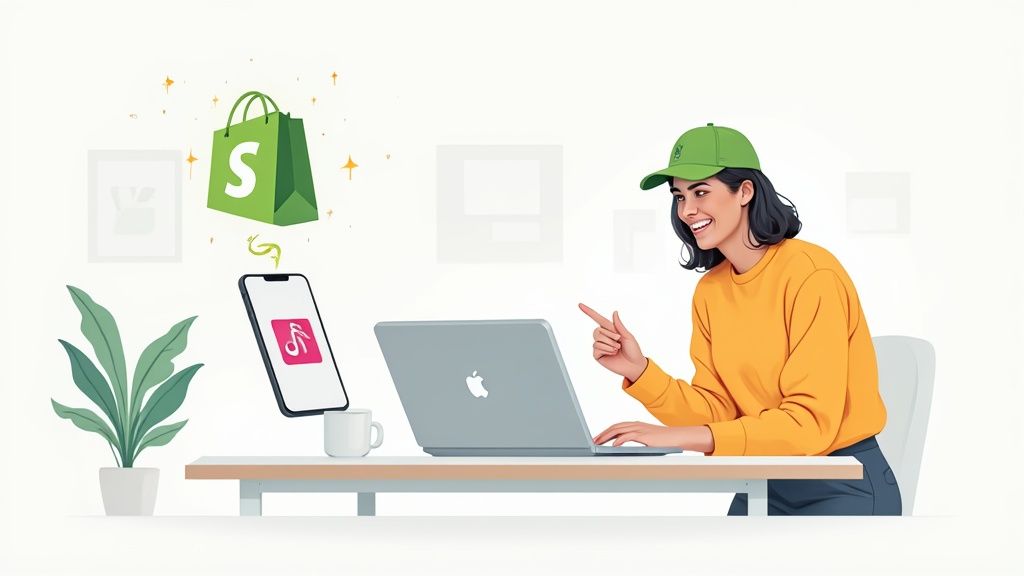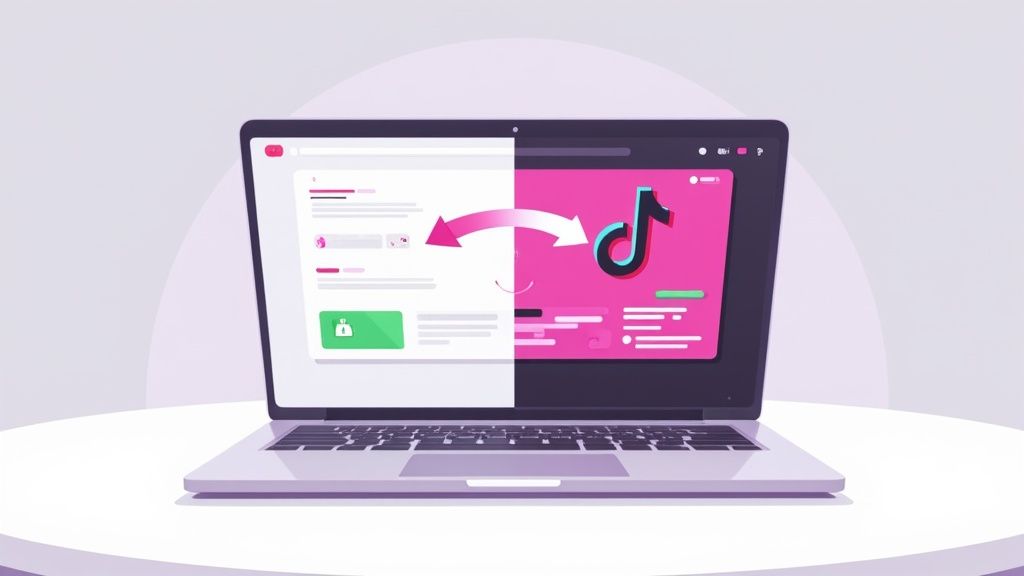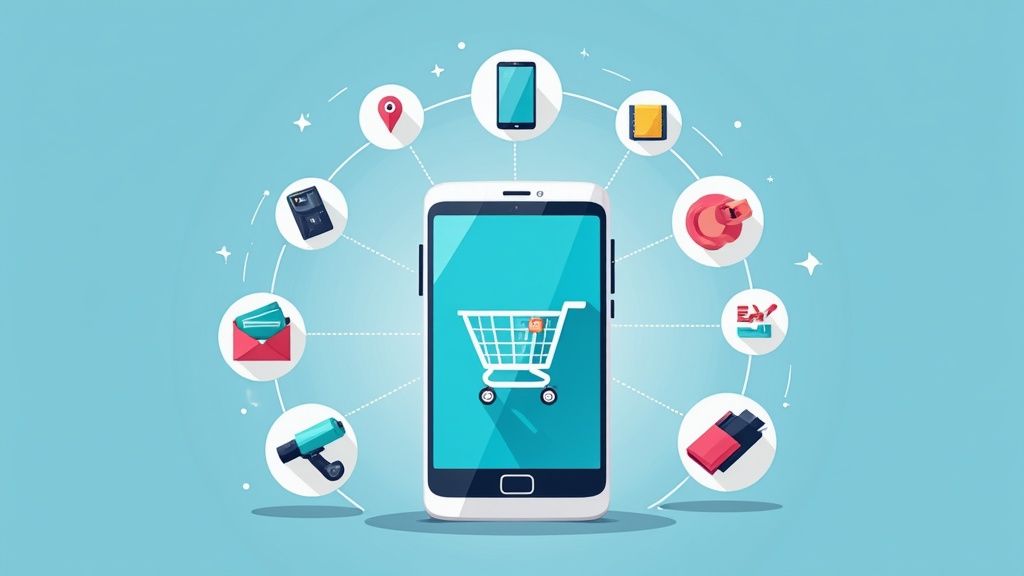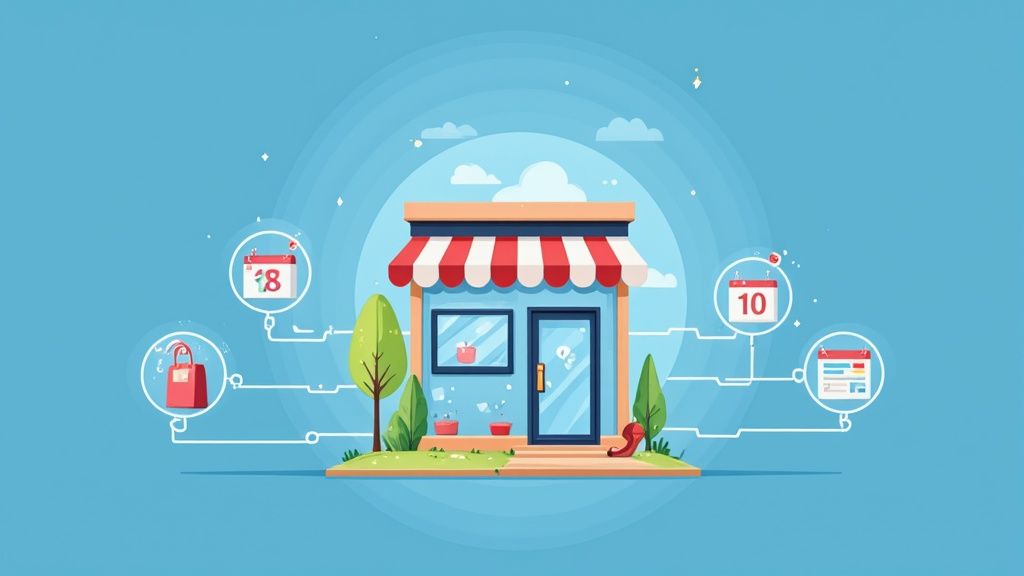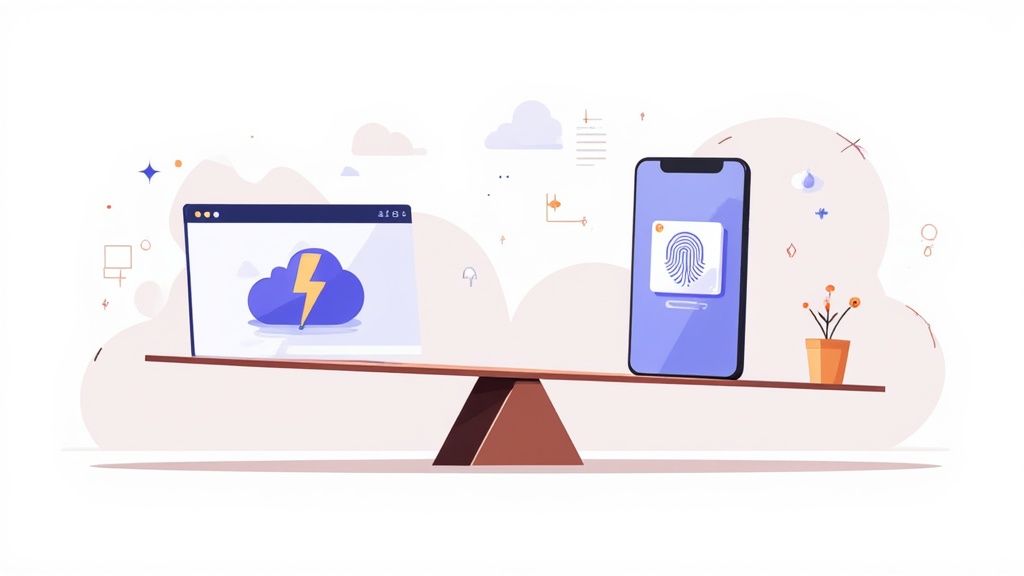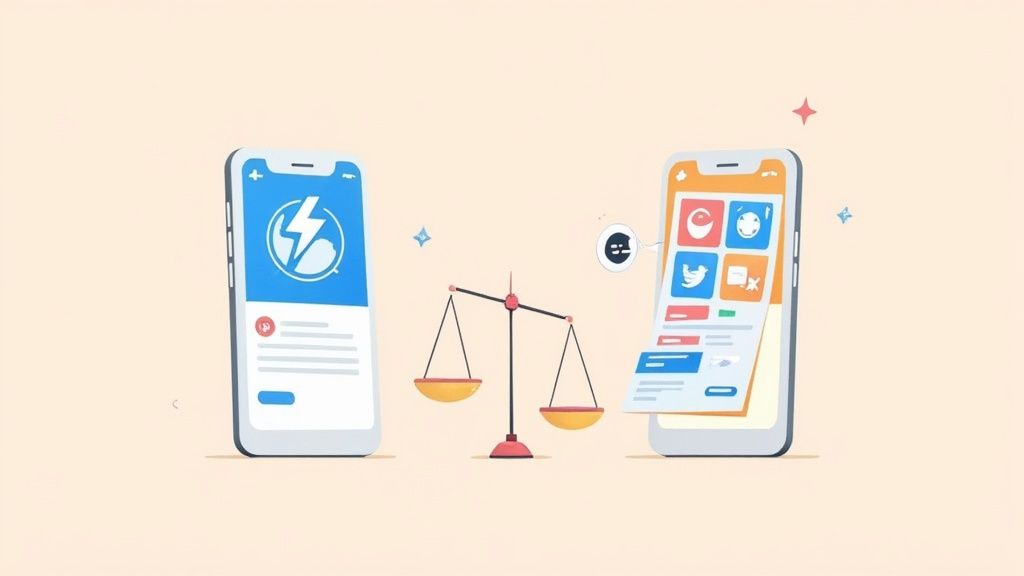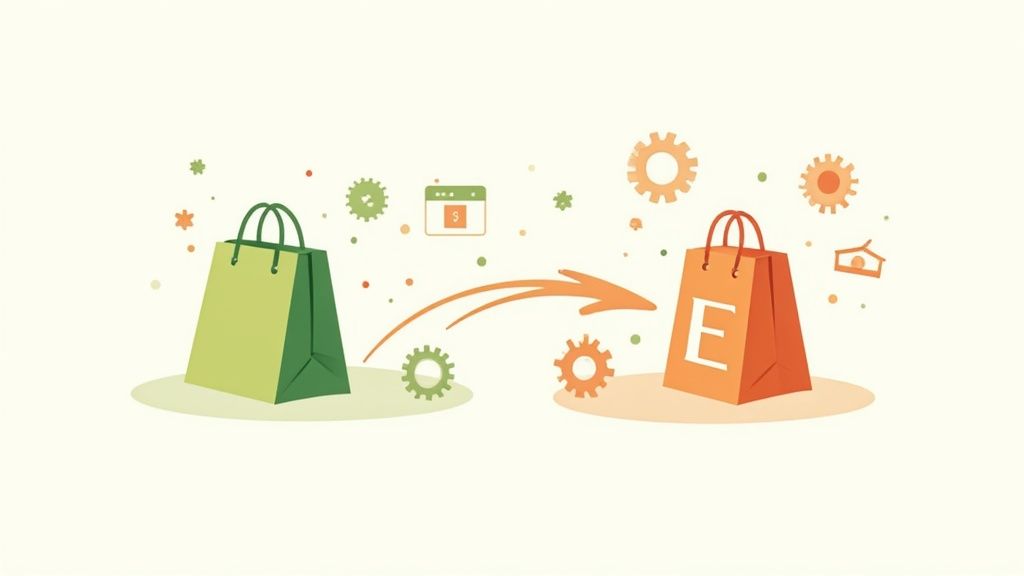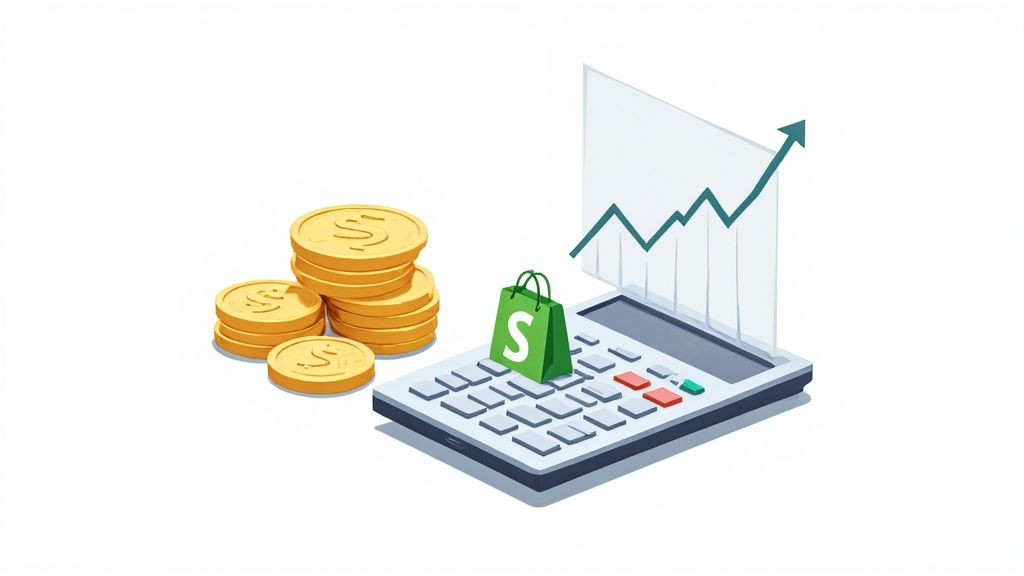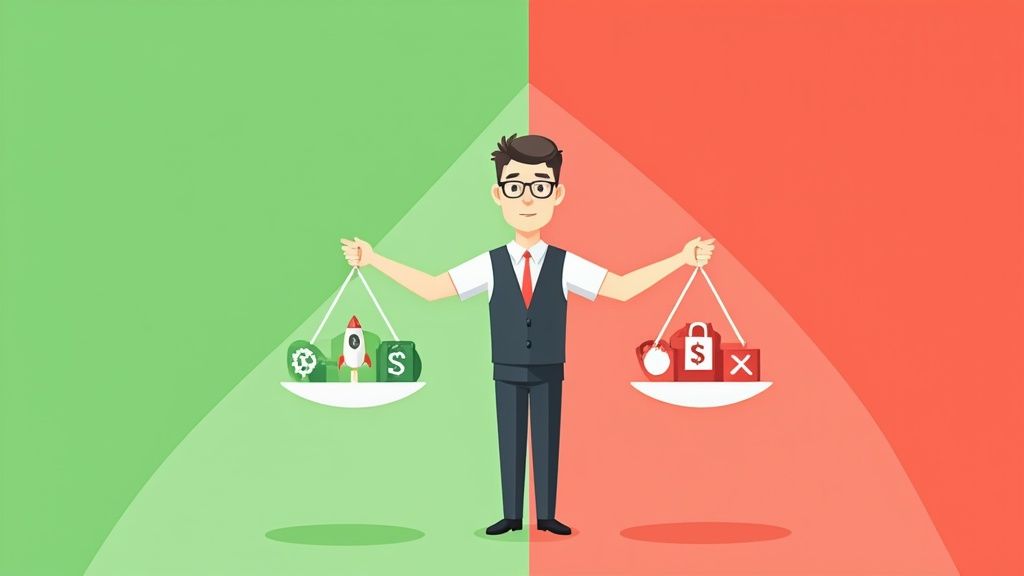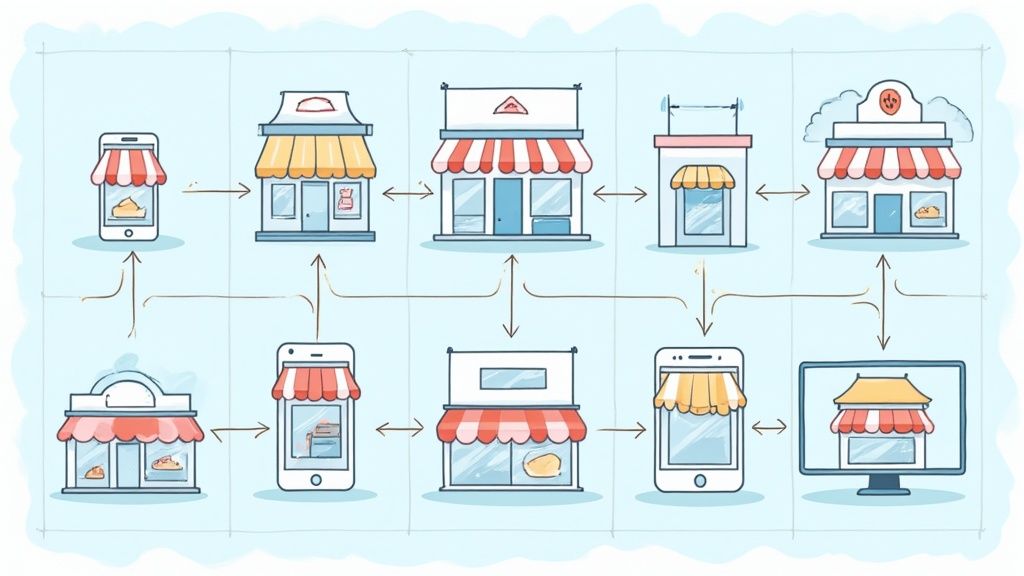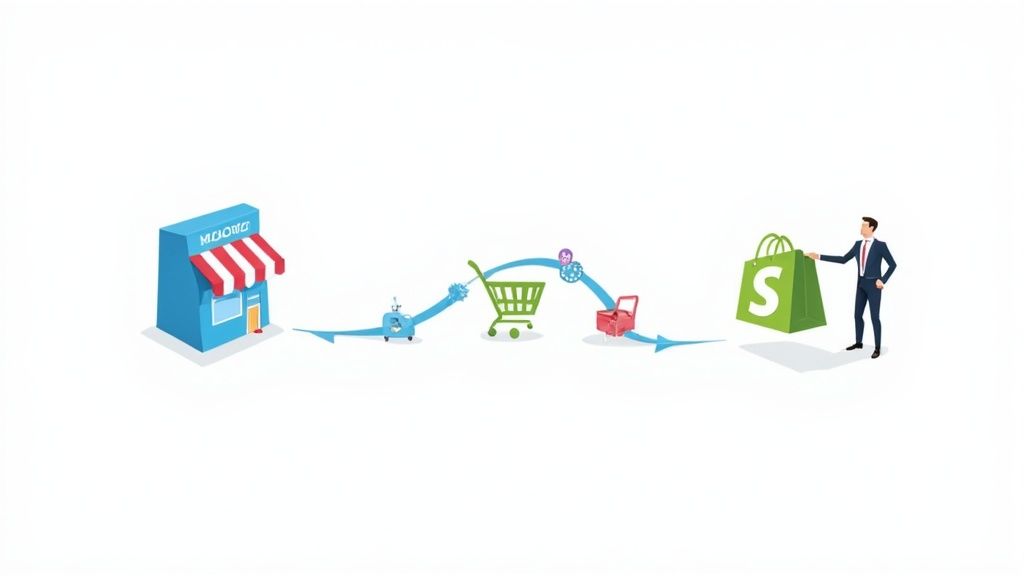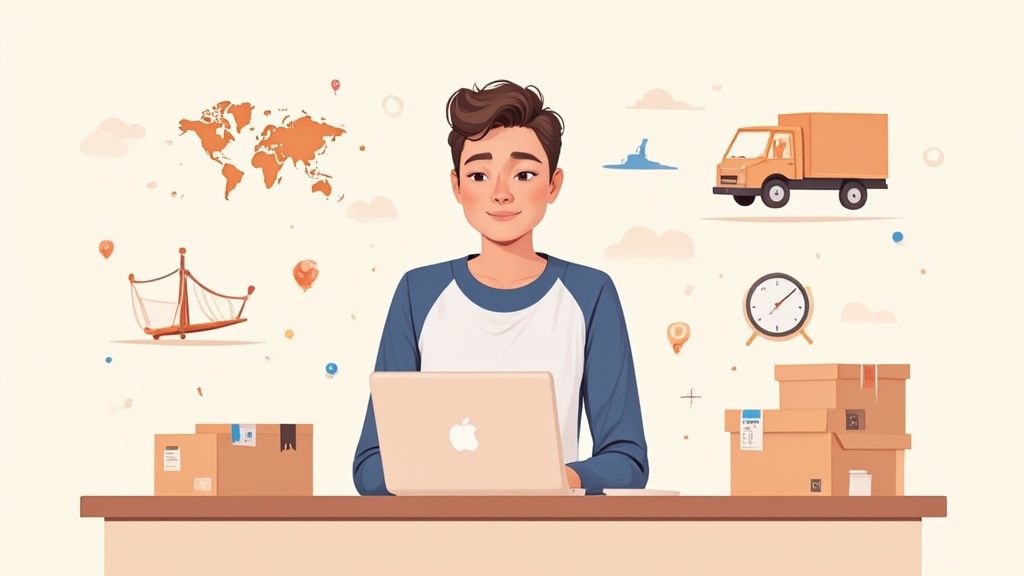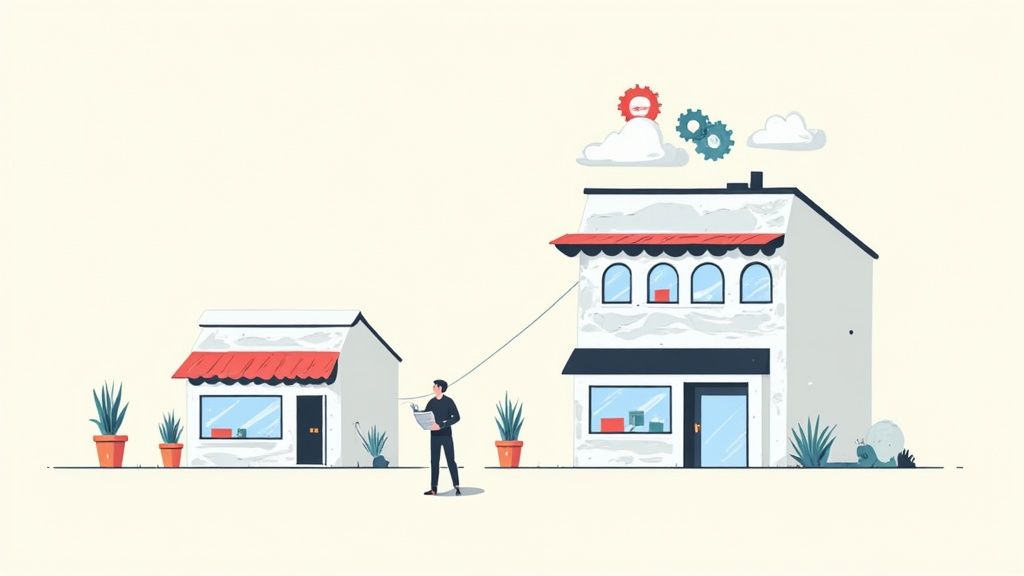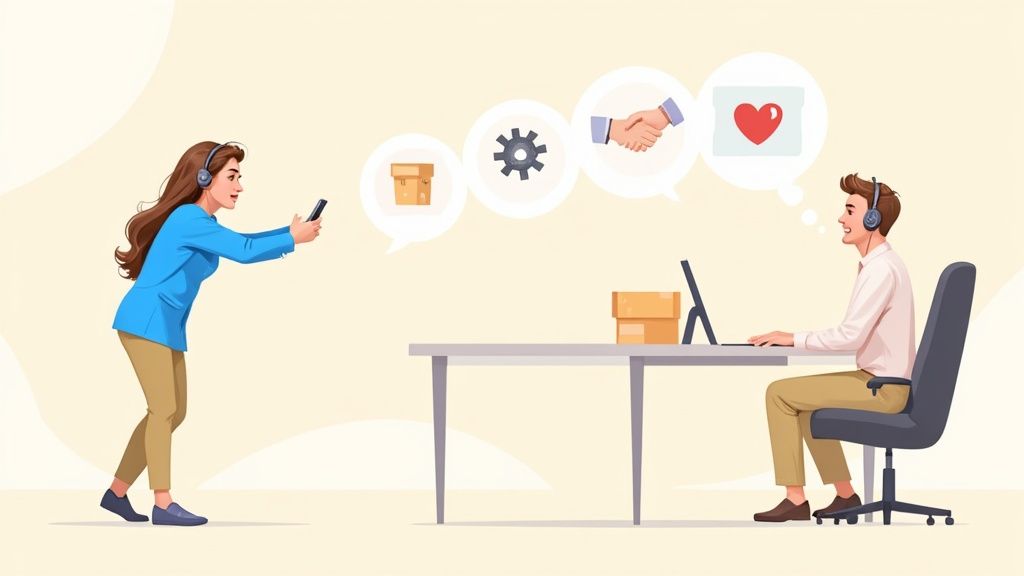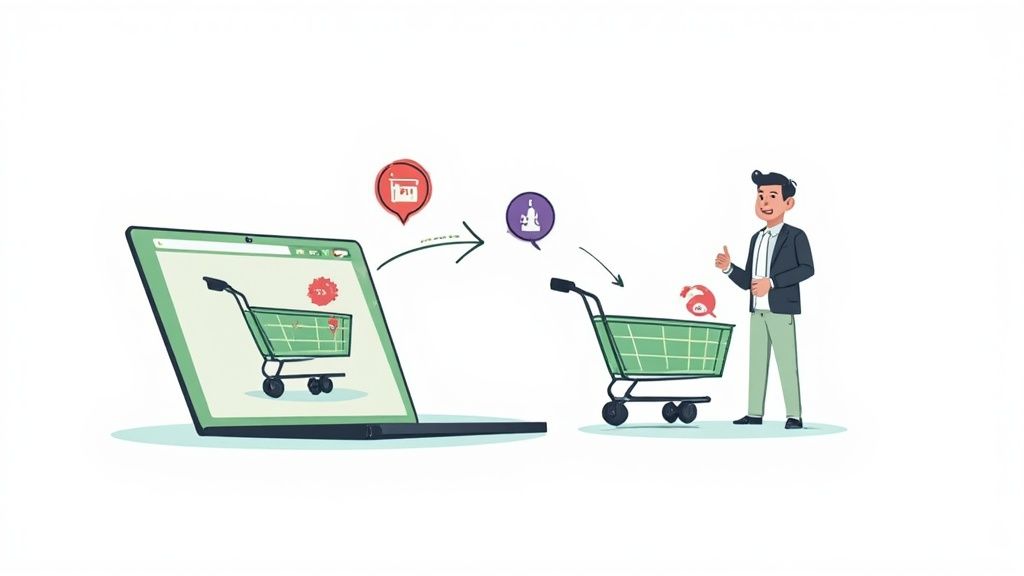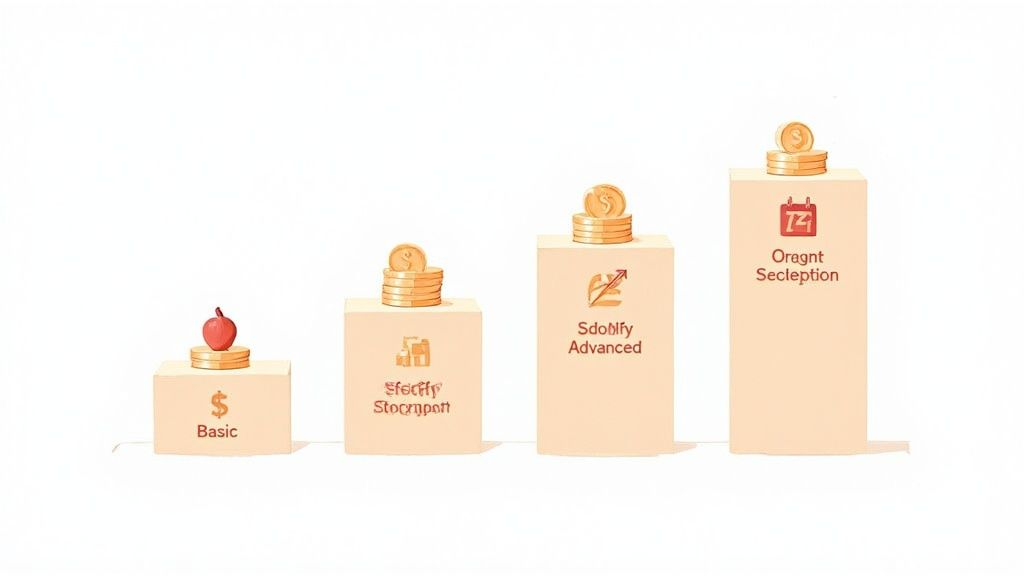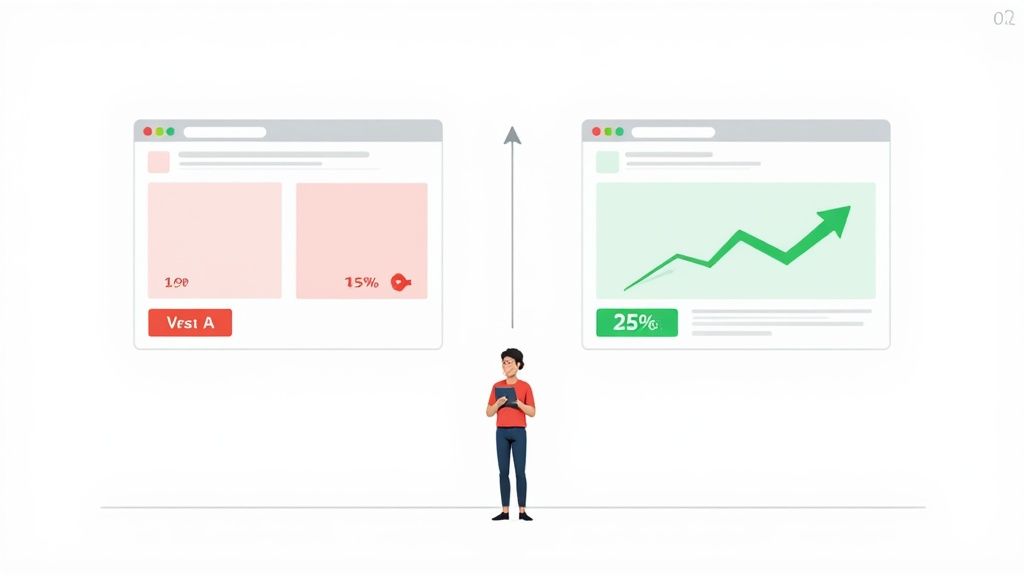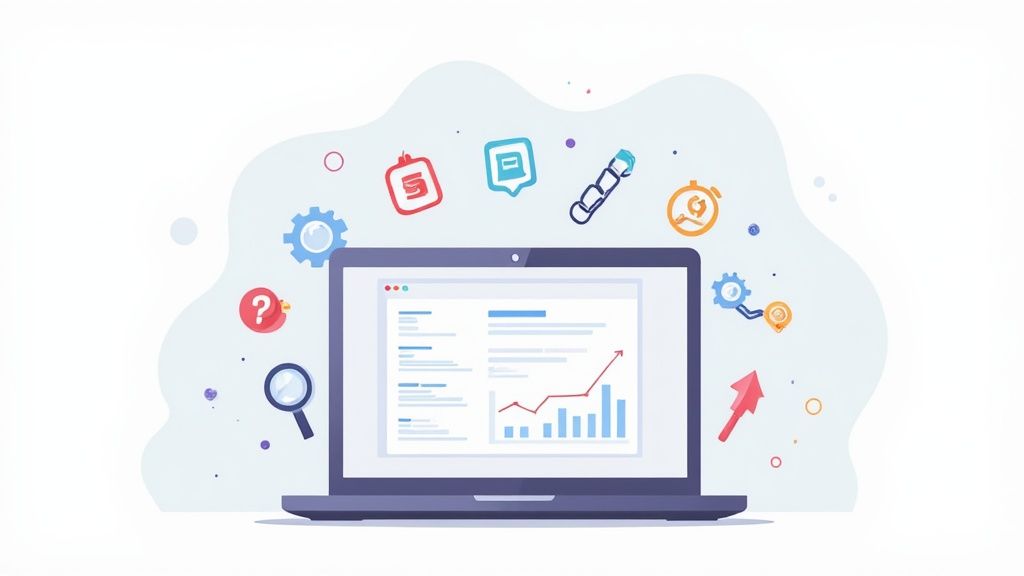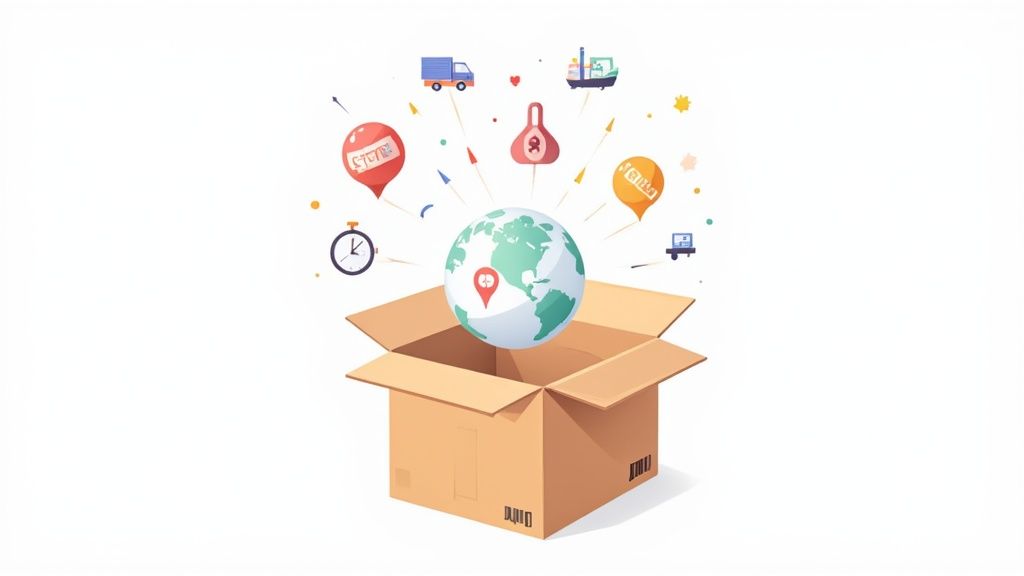
In today's competitive ecommerce landscape, a robust shipping strategy is no longer just a backend operation. It's a critical component of your customer experience and a powerful lever for growth. The right approach can reduce cart abandonment, increase customer lifetime value, and protect your profit margins. From nimble startups to enterprise-level Shopify brands, mastering logistics is key to scaling effectively.
An optimized fulfillment process directly impacts customer satisfaction and your bottom line. How you price your shipping, the delivery speed you offer, and the condition in which products arrive are all vital touchpoints that define your brand. A poorly executed strategy leads to lost sales and damaged reputation, while a great one builds loyalty and encourages repeat business. A critical aspect of a competitive shipping strategy also involves robust measures for cargo theft prevention to safeguard inventory and ensure customer satisfaction, protecting both your assets and your brand's reliability.
This guide breaks down 10 essential ecommerce shipping strategies, providing actionable insights to help you choose and implement the right models for your business. We'll explore everything from foundational pricing models and fulfillment options like 3PLs to advanced tactics for international expansion and omnichannel delivery. You will gain a clear roadmap to turn shipping from a cost center into a strategic advantage.
We'll cover a comprehensive range of models, including:
- Dropshipping and Print-on-Demand (POD) for asset-light businesses.
- Advanced multi-warehouse networks and Third-Party Logistics (3PL) partnerships for scaling brands.
- Omnichannel options like Buy Online, Pickup In-Store (BOPIS).
- Specialized models for subscription services and sustainable shipping.
Each strategy is detailed with practical implementation steps, helping you build a logistics framework that supports sustainable growth and delights your customers. Let's dive in.
1. Dropshipping
Dropshipping is an order fulfillment method where an eCommerce business doesn't keep the products it sells in stock. Instead, when a store sells a product, it purchases the item from a third party, like a wholesaler or manufacturer, who then ships it directly to the customer. This model significantly lowers the barrier to entry for new entrepreneurs, as it removes the need for inventory investment and warehouse management. It stands out as a foundational ecommerce shipping strategy because it prioritizes agility and minimizes financial risk.

When to Use This Strategy
This approach is ideal for new brands testing product-market fit, businesses offering a wide variety of niche products (like a store selling hundreds of phone case designs), or for adding complementary items to an existing product line without taking on inventory risk. For example, a coffee bean subscription box could dropship brewing equipment. Print-on-demand services like Printful are a popular form of dropshipping for creators selling custom apparel and merchandise.
Actionable Implementation Steps
To effectively integrate dropshipping, focus on supplier quality and operational efficiency.
- Supplier Vetting: Don't just pick the cheapest option on a platform like AliExpress. Order samples to test product quality, packaging, and actual shipping times. Use platforms like Spocket that vet suppliers, particularly those in the US and EU, for faster and more reliable shipping.
- Automate Order Flow: Manually forwarding every order is not scalable. Use Shopify apps like DSers (formerly Oberlo) to automatically send customer orders to your supplier. This syncs tracking information and inventory levels, reducing manual errors and saving significant time.
- Transparent Communication: Be upfront with customers about shipping times, especially if products are coming from overseas. Add a dedicated shipping policy page and include estimated delivery windows on product pages to manage expectations and reduce customer service inquiries.
Key Insight: The success of a dropshipping business isn't about finding a product; it's about finding a reliable fulfillment partner. Your supplier's performance directly reflects on your brand, making rigorous vetting non-negotiable.
2. Fulfillment by Amazon (FBA)
Fulfillment by Amazon (FBA) is an eCommerce shipping strategy where sellers send their products to Amazon's fulfillment centers. Once there, Amazon handles the entire logistics process: storing the inventory, picking and packing orders, and shipping products directly to customers. This model allows merchants to leverage Amazon's world-class logistics network and offer benefits like Prime two-day shipping, which significantly enhances customer trust and conversion rates. It essentially outsources the most complex parts of fulfillment to a global leader.
When to Use This Strategy
FBA is ideal for businesses that generate a significant portion of their sales through the Amazon marketplace and want to scale quickly without building their own logistics infrastructure. It's particularly powerful for brands like Anker, who built an empire on the platform by leveraging FBA for rapid, reliable delivery. It's also a great option for sellers with fast-moving, standardized products where the FBA fee structure is more cost-effective than managing in-house or 3PL fulfillment.
Actionable Implementation Steps
To succeed with FBA, you must focus on cost management and inventory optimization.
- Calculate Fees Meticulously: FBA involves multiple fees (fulfillment, monthly storage, long-term storage, referral). Use Amazon's free FBA Revenue Calculator to model your profitability for each product before sending inventory. Miscalculating these costs can erase your margins.
- Optimize Inventory Levels: Avoid costly long-term storage fees by maintaining a lean inventory. Use Amazon's built-in tools like the Inventory Performance Index (IPI) score to monitor sell-through rates and restock recommendations. Aim to keep just enough stock to cover demand without incurring penalties.
- Master Product Prep and Listing: Follow Amazon's strict requirements for product prep, labeling, and packaging to avoid shipment rejection or unexpected fees. Simultaneously, optimize your product listings with high-quality images and keyword-rich copy to align with Amazon's A9 search algorithm, ensuring your FBA products are visible to Prime customers.
Key Insight: FBA isn't just a shipping service; it's an entry ticket into Amazon's high-converting Prime ecosystem. Your success depends less on shipping logistics and more on mastering Amazon's internal rules for fees, inventory management, and product visibility.
3. Multi-Warehouse Distribution Network
A multi-warehouse distribution network involves storing inventory in multiple fulfillment centers across different geographic regions. By placing products closer to clusters of customers, businesses can significantly cut down on shipping distances, which in turn reduces delivery times and carrier costs. This model is a powerful evolution for scaling brands, transforming logistics from a cost center into a competitive advantage by enabling faster, more affordable delivery that meets modern consumer expectations.

When to Use This Strategy
This strategy is essential for established brands with a high volume of orders distributed nationally or internationally. If your shipping data shows that a significant percentage of your customers are concentrated in specific regions far from your primary warehouse, it's time to consider expansion. For example, a brand based in California shipping 40% of its orders to the East Coast could open a warehouse in New Jersey to offer 2-day shipping to that entire market. It is also critical for businesses selling products where delivery speed is a key purchasing factor, such as perishable goods or time-sensitive items.
Actionable Implementation Steps
Successfully managing a distributed inventory network requires a focus on technology and data-driven decision-making.
- Analyze Customer Location Data: Use your historical order data to create a heat map of your customer base. Platforms like Shopify Analytics or dedicated logistics software can identify your key demand centers. Use this data to strategically choose locations for new warehouses that will have the maximum impact on reducing shipping zones and costs.
- Implement a Centralized Inventory System: A robust Inventory Management System (IMS) or Warehouse Management System (WMS) is non-negotiable. Tools like ShipBob or Flexe offer both the physical warehouse network and the software to sync inventory levels across all locations in real-time, preventing stockouts and ensuring orders are routed to the most efficient fulfillment center.
- Automate Order Routing: Configure your system to automatically route incoming orders to the warehouse closest to the customer. This can be based on inventory availability and shipping cost. Advanced rules can also factor in carrier performance and warehouse capacity to further optimize fulfillment.
Key Insight: A multi-warehouse strategy isn't just about adding more buildings; it's about intelligently positioning inventory. The goal is to shrink the average shipping zone for your orders, which directly lowers costs and shortens the "click-to-door" time for your customers.
4. Same-Day and Next-Day Delivery
Same-day and next-day delivery are premium fulfillment strategies focused on getting products into customers' hands within 24 hours or less. By offering unparalleled speed, these services meet the modern consumer's demand for instant gratification, transforming shipping from a logistical necessity into a powerful competitive advantage. This approach is one of the most potent ecommerce shipping strategies for capturing high-value, time-sensitive customers who are willing to pay a premium for convenience.
When to Use This Strategy
This strategy is most effective for businesses selling high-urgency products like last-minute gifts, essential goods (groceries, pharmaceuticals), or electronics in dense, urban markets. It's also a powerful differentiator for brands competing directly with retail giants like Amazon. For example, a local florist can guarantee same-day delivery for Valentine's Day, or a city-based apparel brand can offer next-day delivery for a weekend outfit, creating an experience that online-only competitors can't match.
Actionable Implementation Steps
Successfully launching an expedited delivery service requires precise inventory management and robust local logistics.
- Geo-Fenced Rollout: Don't offer same-day delivery nationwide from day one. Start by targeting a specific high-density urban area or a single postal code where you have localized inventory. This allows you to test the model, optimize routes, and control costs before expanding.
- Partner with Local Couriers: Building your own delivery fleet is complex and expensive. Instead, partner with specialized local courier services that already have the infrastructure and route optimization technology. To meet increasing customer demand for speed, exploring Australia's guide to fast courier services is essential for implementing successful same-day and next-day delivery options.
- Strategic Inventory Placement: You must hold stock close to your end customers. Utilize urban fulfillment centers, micro-warehouses, or even dedicated stockrooms in retail locations to serve as local distribution hubs. This ensures you can meet the promised delivery window without fail.
Key Insight: Same-day delivery is less about shipping and more about hyperlocal inventory management. Your success depends entirely on your ability to accurately position products within a few miles of your target customers.
5. Print-on-Demand (POD) Fulfillment
Print-on-demand (POD) is a specialized fulfillment model where products like apparel, mugs, and art prints are only created after a customer places an order. Unlike traditional retail, there is no upfront inventory investment or bulk manufacturing. Instead, your designs are digitally stored, and when an order comes through your store, a third-party POD provider prints the product, packages it, and ships it directly to your customer. This model is a cornerstone ecommerce shipping strategy for creative entrepreneurs and brands focused on unique, customized merchandise.
When to Use This Strategy
This strategy is perfect for creators, artists, and influencers looking to monetize their audience without handling inventory or logistics. It's also an excellent way for established brands to test new product designs or launch merchandise lines with zero financial risk. For example, a popular podcast could sell branded t-shirts and mugs using a service like Printful, or an artist could sell their designs on posters and phone cases through an Etsy integration. The model thrives on niche markets where unique designs command premium prices.
Actionable Implementation Steps
Success in POD relies on high-quality products and efficient automation to protect your brand's reputation.
- Vet Provider and Product Quality: Never launch a product without first ordering samples. Evaluate the print quality, material durability, and packaging presentation from different POD providers. A cheap-feeling t-shirt with a faded print will quickly lead to negative reviews, so test providers like Printify or Gelato to find one that meets your quality standards.
- Automate Your Workflow: Manually processing each order is unsustainable. Integrate your POD provider directly with your Shopify store. This connection automatically sends order details for fulfillment, syncs inventory for blank products, and pushes tracking information back to the customer, creating a seamless, hands-off process.
- Focus on Niche Designs: The POD market is saturated with generic designs. Differentiate yourself by creating high-quality, targeted artwork for a specific niche, whether it's for rock climbing enthusiasts or fans of a particular video game. High-quality designs justify higher price points and build a loyal customer base.
Key Insight: With print-on-demand, you are not just selling a product; you are selling a design. Your competitive advantage comes from creative, unique artwork and strategic niche targeting, while your fulfillment partner handles the complex logistics.
6. Sustainable and Eco-Friendly Shipping
Sustainable and eco-friendly shipping involves integrating environmentally conscious practices into every stage of the fulfillment process. This strategy goes beyond just using recycled boxes; it encompasses everything from carbon-neutral delivery options and biodegradable packaging to consolidated shipments and partnerships with green logistics providers. As consumers increasingly prioritize sustainability, adopting these practices is not only an ethical choice but also a powerful brand differentiator that can attract and retain a loyal customer base.
When to Use This Strategy
This strategy is particularly effective for brands whose identity is built on ethical or natural values, such as those in the sustainable fashion, organic beauty, or wellness industries. Companies like Allbirds and Patagonia have made eco-friendly practices a core part of their brand story. It's also a crucial consideration for any business aiming to meet Corporate Social Responsibility (CSR) goals or appeal to a younger, more environmentally aware demographic that actively seeks out and supports sustainable businesses.
Actionable Implementation Steps
To meaningfully integrate sustainable ecommerce shipping strategies, focus on tangible changes in packaging, logistics, and customer-facing options.
- Rethink Your Packaging: Switch from traditional plastic mailers and fillers to sustainable alternatives. Use materials like compostable mailers from providers like Hero Packaging, mushroom packaging, or recycled cardboard. Conduct a packaging audit to eliminate unnecessary materials and reduce the overall size and weight of your shipments.
- Offer Carbon-Neutral Shipping: Use apps like Shopify's Planet to automatically calculate shipping emissions and fund carbon removal projects for every order. This allows you to offer carbon-neutral shipping to your customers, often at no extra cost to them, and clearly market this benefit on your site.
- Promote Shipment Consolidation: Encourage customers to consolidate items into a single shipment rather than opting for multiple, faster deliveries. You can incentivize this behavior by offering a small discount or loyalty points for choosing a slower, consolidated shipping option at checkout, which reduces both costs and carbon footprint.
Key Insight: True sustainability in shipping isn't just a marketing claim; it's a series of operational choices. The most successful brands embed these practices into their fulfillment workflow and communicate their impact transparently, turning an operational detail into a core brand value.
7. White-Label and 3PL (Third-Party Logistics) Partnerships
Partnering with a third-party logistics (3PL) provider means outsourcing your order fulfillment operations, from warehousing and inventory management to picking, packing, and shipping. A 3PL acts as the operational backbone of your business, handling the physical movement of goods so you can focus on core activities like marketing, product development, and customer acquisition. This model is one of the most scalable ecommerce shipping strategies, enabling rapid growth without the massive capital investment required for building in-house logistics infrastructure.
When to Use This Strategy
This strategy is ideal for growing eCommerce brands whose order volume is becoming too large to handle in-house but who aren't ready to lease and staff their own warehouse. It's a critical step when your business is scaling nationally and needs to offer faster, more affordable shipping by distributing inventory across multiple fulfillment centers. Companies like ShipBob and Red Stag Fulfillment specialize in direct-to-consumer fulfillment, making them perfect partners for brands moving beyond the startup phase.
Actionable Implementation Steps
Choosing and managing a 3PL partner is crucial for maintaining brand consistency and customer satisfaction.
- Establish Clear Service Level Agreements (SLAs): Don't just agree to terms; define them precisely. Your SLA should specify critical metrics like order accuracy rates (e.g., 99.8%+), dock-to-stock time (how quickly they process inbound inventory), and order cutoff times for same-day shipping. These are your contractual guarantees of service quality.
- Integrate Your Tech Stack: Ensure the 3PL’s software integrates seamlessly with your eCommerce platform (like Shopify). This provides real-time inventory visibility across all locations, automates order syncing, and pushes tracking information back to your store without manual intervention. This prevents overselling and keeps customers informed.
- Negotiate for Scalability: Discuss pricing tiers and scalability clauses from the start. As your order volume grows, your cost-per-order should decrease. Also, ensure your contract outlines procedures and costs for handling peak season surges, like Black Friday, so you are not caught off guard by unexpected fees.
Key Insight: A 3PL isn't just a vendor; they are a direct extension of your brand experience. The unboxing experience, shipping speed, and order accuracy are all in their hands, making a culturally aligned and technologically integrated partner essential for long-term success.
8. Subscription Box and Recurring Shipment Model
The subscription box model is a fulfillment strategy centered on sending regular, predictable shipments to customers who have subscribed to receive them on a recurring basis. Instead of facilitating one-off purchases, this approach focuses on building a long-term relationship where customers receive curated products or replenishables at set intervals, like weekly, monthly, or quarterly. This model transforms shipping from a reactive, per-order function into a proactive, predictable logistical operation, which is a key reason it’s one of the most powerful ecommerce shipping strategies for building customer lifetime value.
When to Use This Strategy
This strategy is perfect for businesses with consumable products (coffee, supplements, pet food), curated discovery experiences (beauty samples like Birchbox, snack boxes like NatureBox), or essential replenishment items (razors from Dollar Shave Club). It is also highly effective for brands aiming to increase predictable revenue streams and improve inventory forecasting. If your products are used regularly and your goal is to lock in customer loyalty and move away from a transactional sales model, a subscription service is an ideal fit.
Actionable Implementation Steps
Successful subscription models hinge on operational excellence and customer flexibility.
- Implement a Robust Subscription Management Platform: Manually tracking recurring orders is impossible at scale. Use a dedicated Shopify app like Recharge or Bold Subscriptions to automate billing, manage customer portals, and handle recurring order generation. These tools allow customers to self-manage their subscriptions (skip, pause, or swap items), which significantly reduces churn.
- Optimize Fulfillment for Predictable Volume: Since you know exactly how many boxes need to be shipped and when, you can optimize your fulfillment process. Plan "packing days" to prepare all subscription boxes at once, which streamlines labor and reduces errors. This also allows you to negotiate better rates with carriers based on predictable, bulk shipment volumes.
- Communicate Proactively: Send automated email or SMS notifications to subscribers a few days before their order is processed and shipped. This reminder gives them a chance to update their address, skip a shipment, or add one-time items to their box. This transparency reduces failed payments, minimizes customer service tickets, and improves the overall experience.
Key Insight: The subscription model shifts the focus from optimizing a single shipment to optimizing a recurring customer relationship. Success depends less on the individual transaction and more on the seamless, predictable, and flexible experience you provide over time.
9. Buy Online, Pickup In-Store (BOPIS) and Omnichannel Fulfillment
Buy Online, Pickup In-Store (BOPIS) is a hybrid fulfillment model that merges the convenience of online shopping with the immediacy of physical retail. Customers place an order through an eCommerce site and collect their items from a nearby brick-and-mortar location, often on the same day. This omnichannel approach leverages existing physical stores as micro-fulfillment centers, transforming them from simple sales points into strategic logistics hubs that cater to modern customer expectations for speed and flexibility.
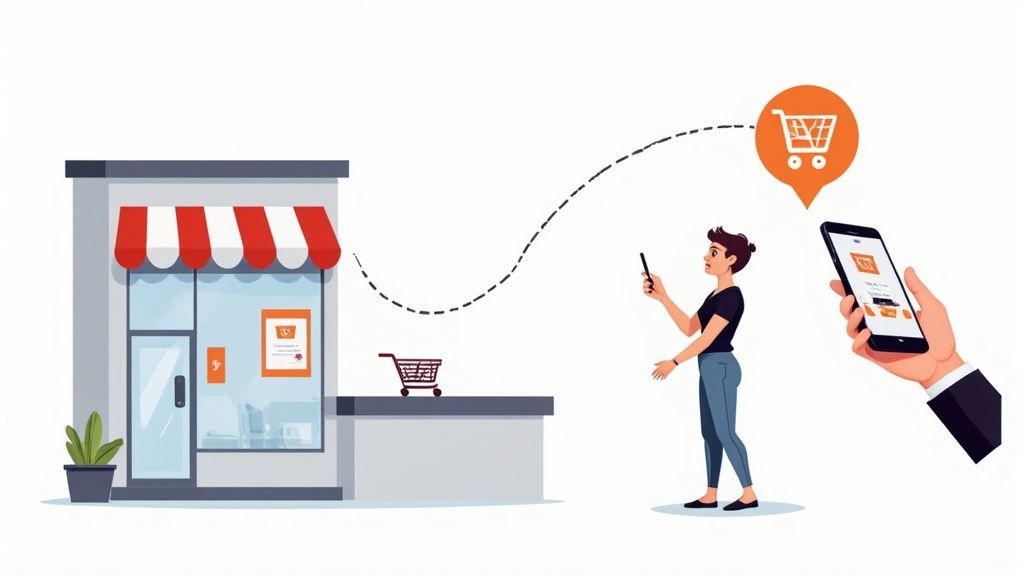
When to Use This Strategy
This strategy is essential for established retailers with both an online presence and physical storefronts, like Target or Best Buy. It's particularly powerful for businesses looking to reduce shipping costs, drive foot traffic to physical locations, and compete with the rapid delivery times offered by eCommerce giants. BOPIS is also ideal for products where customers may want to see the item before taking it home or for urgent purchases where waiting for delivery is not an option.
Actionable Implementation Steps
Successfully launching a BOPIS program requires tight integration between digital and physical operations.
- Unify Inventory Management: Implement a real-time inventory system that syncs across your website and all physical store locations. A tool like Shopify POS can bridge this gap, ensuring that online customers can only order items that are verifiably in stock at their chosen pickup location, preventing fulfillment failures. For more details, you can learn about setting up Shopify shipping options.
- Optimize In-Store Operations: Designate a specific, clearly marked area in your store for pickups. Train retail staff on the entire BOPIS workflow, from receiving online order notifications to locating items and handing them off to the customer. A smooth, fast pickup experience is critical for customer satisfaction.
- Automate Customer Notifications: Use automated emails and SMS messages to keep customers informed at every step. Send an immediate order confirmation, a notification when the order is ready for pickup, and a final confirmation after collection. Include clear instructions, store hours, and what the customer needs to bring (e.g., ID, order number).
Key Insight: BOPIS is more than a shipping alternative; it's a customer experience strategy. A seamless pickup process can increase in-store sales, as customers who come to collect an order often make additional, unplanned purchases.
10. Regional and International Expansion Logistics
Regional and international expansion involves strategically extending your fulfillment network to serve customers in new geographic markets. This is more than just offering international shipping; it's a comprehensive approach that involves navigating customs, duties, local carrier networks, and varying customer expectations. For growing brands, successfully managing these logistics is the key to unlocking global revenue streams and establishing a worldwide presence. It’s a vital ecommerce shipping strategy for scaling beyond your home market.
When to Use This Strategy
This strategy is for established brands that have saturated their domestic market or are seeing significant, organic demand from specific international regions. It's the logical next step when your data shows a high volume of cross-border orders or frequent website traffic from a particular country or continent. For instance, a US-based apparel brand noticing a surge in sales from the UK and Germany should consider establishing a European fulfillment node to better serve those customers.
Actionable Implementation Steps
To execute a successful international expansion, focus on simplifying complexity for both your business and your customers.
- Calculate Landed Costs: Be transparent about all costs. Use tools like Shopify Markets or apps like Zonos to calculate and display duties, taxes, and fees directly at checkout. This "Delivery Duty Paid" (DDP) approach prevents surprise charges for the customer upon delivery, which is a major cause of cart abandonment and failed deliveries.
- Partner with Global Logistics Experts: Don't try to navigate complex customs regulations alone. Partner with a 3PL that has a global fulfillment network, like ShipBob or Flexport, or use carriers with robust international services like DHL eCommerce Solutions. They handle customs documentation, carrier negotiations, and regional warehousing.
- Localize the Experience: Adapt your shipping and returns policy for each target market. Offer popular local payment methods and provide customer support that understands regional nuances. A localized experience builds trust and shows commitment to your new customer base. For a deeper dive into this topic, you can learn more about cross-border ecommerce strategies.
Key Insight: International expansion is not just a logistics project; it's a customer experience project. The brands that win are those that make buying from another country feel as simple and secure as buying from a local store.
Ecommerce Shipping Strategies: 10-Point Comparison
Choosing Your Next Move: How to Implement the Right Shipping Strategy
Navigating the complex landscape of ecommerce shipping strategies can feel like charting a course through open waters. We've explored a comprehensive map of options, from the asset-light models of dropshipping and print-on-demand to the logistically intensive operations of multi-warehouse distribution and international expansion. Each strategy offers a unique set of advantages tailored to different business models, growth stages, and customer expectations. The core takeaway is clear: shipping is no longer a simple cost center. It is a strategic lever for brand differentiation, customer loyalty, and sustainable growth.
The strategies discussed, including Fulfillment by Amazon (FBA), same-day delivery, and eco-friendly packaging, are not mutually exclusive. The most successful brands often blend several approaches to create a resilient and responsive fulfillment network. A brand might leverage a 3PL partner for its core domestic orders, utilize FBA to tap into the Prime customer base, and manage a small in-house team for custom subscription box orders. This hybrid approach allows for flexibility, risk mitigation, and the ability to meet diverse customer needs.
The ultimate goal is to transform your shipping operations from a logistical necessity into a powerful competitive advantage. A well-executed strategy directly impacts your bottom line by reducing cart abandonment, increasing conversion rates, and fostering the kind of positive post-purchase experience that earns repeat business.
From Insights to Implementation: Your Action Plan
Feeling overwhelmed by the possibilities is natural. The key is to move from analysis to action with a structured, data-driven approach. Don't try to overhaul your entire system overnight. Instead, focus on iterative improvements that address your most significant pain points or opportunities. Here’s a practical roadmap to get you started:
1. Audit Your Current State:Before charting a new course, you need to know your current position. Conduct a thorough audit of your shipping operations.
- Analyze Your Data: Dive into your Shopify analytics and any shipping software data. What are your average shipping costs? What’s your time-to-fulfillment? Where are your most common shipping destinations?
- Gather Customer Feedback: Use surveys and review your support tickets. Are customers complaining about shipping speed, cost, or packaging? Understanding their perception is invaluable.
- Map Your Process: Document every step of your current fulfillment process, from order receipt to final delivery. Identify bottlenecks, inefficiencies, and areas for potential automation.
2. Prioritize One Key Initiative:Based on your audit, select a single, high-impact strategy to implement first.
- For Emerging Brands: Your focus might be on establishing a reliable partnership with a 3PL to free up your time for marketing and product development.
- For Growing Brands: The priority could be testing a multi-warehouse strategy to reduce shipping times and costs to key customer regions.
- For Enterprise Brands: The next move might involve a sophisticated omnichannel approach like BOPIS or a full-scale international expansion plan.
3. Build a Phased Rollout Plan:Once you’ve chosen your initiative, break the implementation down into manageable phases. For example, if you're launching international shipping, you might start with a single target country or region. If you're adopting sustainable packaging, begin with one product line to test new materials and gather feedback. A phased approach minimizes risk and allows you to learn and adapt as you go.
By systematically evaluating your needs, prioritizing with intention, and executing a thoughtful plan, you can build an ecommerce shipping strategy that not only meets today's demands but also scales for tomorrow's growth. Your shipping and fulfillment operations are the final, critical touchpoint in the customer journey; make sure they leave a lasting, positive impression.
Executing sophisticated ecommerce shipping strategies requires more than just a plan; it demands deep technical expertise in platforms like Shopify, a sharp eye for conversion rate optimization, and a strategic partner to guide you. If you're ready to transform your shipping from a challenge into your greatest strength, the team at ECORN can help. Schedule a consultation with our experts to discover how we build high-performance fulfillment systems that drive growth and delight customers.







